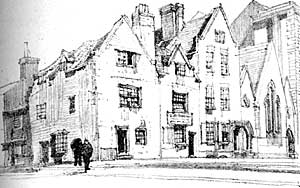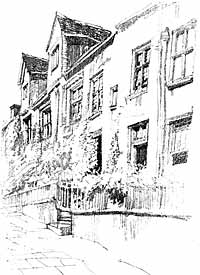< Previous | Contents | Next >
Granby Street, Spaniel Street and Friar Lane
Granby Street is only of interest for its name, for it, together with Rutland Street, represents very nearly the last land held in Nottingham by the great Rutland family. How they came into possession of this land we shall see when studying the Friary, but meanwhile it is well to remember that Granby was one of the names of the family.
It was in Granby Street that in 1841 stood Messrs. Court & Company's foundry. It has completely disappeared, but in its day it was of very great importance. Messrs. Court made the first of the Carrington Street bridges and they did a great deal of iron work about the town such as the palings round Wellington Circus, but perhaps the chief reason why we should remember this foundry is that in the house attached to it, Mrs. Gilbert who has told us much of daily life in Nottingham from seventy to a hundred years ago, spent her girlhood at the western end of Granby Street and the corner of Park Street is a tumble down tenement which I understand was used as the Jews' synagogue of Nottingham before they erected their present premises.

The junction of Spaniel Row with Friar Lane c.1915.
Spaniel Row is a queer little street which has a certain amount of interest. It always seems to have been called Spaniel Row and the popular belief is that in conjunction with Houndsgate it was the kennels for the castle: whether this is so or not I am not prepared to say. Only recently an old house of about King Charles I.'s time numbered No. 1 stood at the corner of Spaniel Row and Friar Lane. In Spaniel Row is a red brick house called the Sheriff's House because in it during the 17th century lived a certain John Reckless who was sometime Sheriff of Nottingham. George Fox the founder of the Society of Friends, or Quakers as we most usually call them, was born at Fenny Drayton, Leicestershire, in 1624. In 1649 when the spirit moved him to wander about the Vale of Belvoir he arrived at Nottingham, where he proceeded to interrupt the service in St. Mary's Church, as we have already seen. Through this misdemeanour he was cast into prison, which he describes as "a nasty stinking place," but it so chanced that Mrs. Reckless was present at St. Mary's on the occasion of this interruption and was so influenced by Fox's testimony that she so arranged matters that he was removed from the gaol to custody in the Sheriff's house, and both she and her husband soon afterwards accepted the Quaker faith and Reckless himself preached in Nottingham Market Place.
The first woman preacher amongst the Quakers was a certain Elizabeth Hooton of Hucknall who visited America and was a terrible sufferer at the hands of the Puritans. Probably the first Quaker meeting-room would be erected in the garden behind Reckless's house, and we have a note that a room was licenced for their worship in 1689 which would probably be this room. At any rate Reckless it is believed was interred in his own garden as burials in consecrated cemeteries were distasteful to the Quaker faith and there was as yet no Quaker burial ground in Nottingham.
A Meeting House was built in Spaniel Row in 1737 which still stands, but which was sold about 1850 to the Catholic Apostolic Church under curious circumstances. It appears that the Quakers proposed to enlarge their Meeting House, but Miss Burton, of whose story we heard something when considering her alms houses on London Road and who lived next door in the house still standing and numbered 3, eventually bought the building from the Society of Friends and re-sold it to the Catholic Apostolic Church who proceeded to provide it with a new facade and otherwise modernize it. However, eventually they removed to Northumberland Street and the chapel is now used as a bleaching house by Messrs. Copestake.
Returning to Friar Lane, the Friends' Meeting House was built in 1847 and next door to it stands their adult school which was removed from East Street in 1869 and which is I believe, the oldest adult school in the kingdom. In front of this meeting house stood until 1926 a small cemetery which contained a fine tree which was an object of great delight showing its great balloon of greenery even in the midst of its turmoil of the busy city, but its beauty and restfulness could not save it and it was all swept away in order to straighten out the road.
Behind the premises of the wholesale Co-operative Society is a Gothic Chapel which was built in 1828 from the designs of a certain Mr. Waller of London. It was used by the Baptist community and later on considerable schools were attached to it. It is noteworthy because of the fact that in addition to two galleries there were underneath it catacombs calculated to hold 500 bodies. Its congregation played an important part in Nottingham, but they seem to have irritated their neighbours, for in 1846 an attempt was made to burn down their premises.
An extraordinary occurrence took place in Friar Lane in 1755. At that time the Mayor of Nottingham lived at a house at the corner of Beastmarket Hill and Friar Lane—the site would be about the middle of the present road—and he was wont to hang up in his front room the town mace, which was a valuable and important piece of workmanship. This raised the cupidity of certain evilly-disposed persons and in due course it was stolen. The thieves were caught and one of them by name of James Shipley was sentenced to seven years transportation to Nova Scotia, but he managed to escape from the coach that was conveying him to the port and after very many adventures and the passage of several years he returned to Nottingham where he remained unmolested and lived respected for the rest of his life.

Dorothy Vernon's House contained remnants of the Carmelite Friary. It was a victim of the widening of Friar Lane in the 1920s.
Friar Yard is undoubtedly the most interesting object in this neighbourhood. It is a quiet backwater and the red brick house directly facing the entrance was the old stamp office of Nottingham. But the chief object of interest is the long row of two-storied houses with dormers which forms the eastern side of this backwater for this is all that remains of the great Carmelite or White Friars' House of Nottingham. The White Friars were one of those many bodies into which the great order of Friars were sundered and they were called White Friars from the colour of the cloak of their habit. They are first heard of in the 12th century and tradition has it that when the Crusaders got through to Mount Carmel they found a body of religious living there who said that they were descendants of Elisha and who wore a white cloak in memory of Elijah's mantle. The order was introduced into England by John Vessey and Richard Grey and they established their first house at Alnwick in Northumberland, and Ailsford in Kent sometime about 1245. They were established in Nottingham in 1276 by Reginald Lord Gray of Wilton and property was given to them which gradually increased until it covered a wide area. It had its boundary wall along Beastmarket Hill and the foundations of this wall were discovered in 1923 as were also many remains of the daily life of the Friars. But the building incorporated in the present edifice has probably a much older history than that connected with the Friars, for all through the early Middle Ages there is constantly mentioned a mysterious chapel of St. James's which stood hereabouts. Its foundation is older than St. Peter's and St. Nicholas's Churches and it appears to have been an appendage of St. Mary's Church. It was used or it is thought to have been used as the Moot Hall of the French Borough after the Conquest and it is firmly believed by a number of antiquarians that this mysterious chapel remains embedded within the later walls of the building we now call The Friary.
At any rate, this building fell into the hands of the Carmelites and there is no doubt that it was used by them as their church, for it is to be noticed that this orientation is exactly right.
The Carmelites pursued their normal course in Nottingham. From time to time there are stories as to their proceedings and as the years rolled on they seem to have degenerated. At any rate in 1532 their Prior killed one of his brethren in a drunken brawl, and we have another note giving an account of an attempted murder at a convivial party held within the Friary in the year 1515. We know that Henry VIII. made offerings in this chapel and it is quite possible that Wolsey spent the night within the walls of the Friary as he was on his way to Leicester in 1530. It was dissolved about that time and the lands were granted to Humphrey Strelley and eventually it was bought by John Manners the younger son of the Earl of Rutland and so the connection between the Rutland family and the property commenced, which terminated as we have seen when considering Granby Street. This John Manners married Dorothy Vernon the daughter of Sir George Vernon, the King of the Peak, and he modernized the Friary into a house suitable for the accommodation of his bride. Much of his work remains embedded in the present edifice and in the strange rooms within the house, and with the garden which still exists at its rear Dorothy Vernon must have been quite familiar. She did not elope with John Manners, the marriage was highly approved by both families, and the romance of her elopement is a pure fiction which was invented by a novelist of the 18th century.
